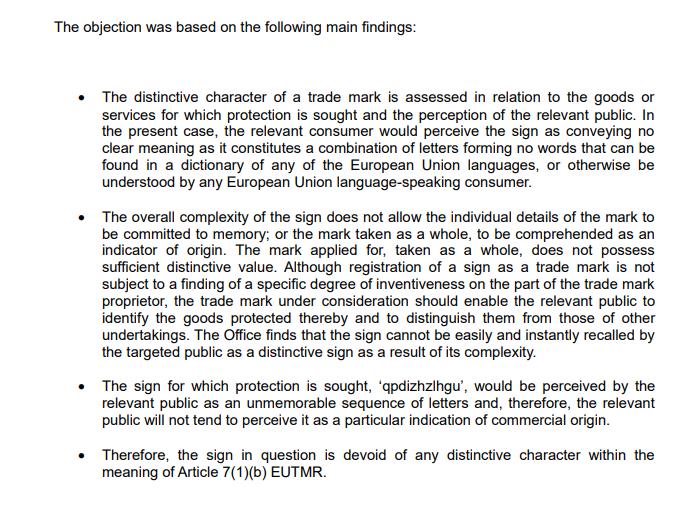The EUIPO is tightening its scrutiny standards to crack down on non-distinctive "random combination trademarks". Trademarks consisting entirely of random combinations of letters and numbers now face a high risk of rejection.
When examining trademark applications, the EUIPO primarily evaluates them based on absolute grounds for refusal, such as distinctiveness, functionality, and potential negative impact. In practice, trademarks without obvious flaws are usually not rejected. However, two recent cases of rapid rejections by the EUIPO have drawn attention in the industry.
These two trademarks were filed by a Chinese company on January 13, 2025, with the names "hstcpgkqyxhs" and "qpdizhzlhgu". Just days later, on January 16 and 17, the EUIPO issued rejection notices, citing the following reasons:


1. The applied-for trademarks consist solely of letter combinations that are not dictionary words in any EU language, nor are they comprehensible to EU consumers based on linguistic conventions.
2. Due to their excessive complexity, the trademarks are difficult to remember and fail to function as identifiers of the origin of goods or services.
Since the applicant did not file a review within the stipulated period, the trademarks were officially rejected and invalidated.

Such "random combination" trademarks first gained attention in the USA five years ago, with an analysis published in The New York Times. These randomly assembled letter combinations are difficult to pronounce or remember, making them ineffective as trademarks and unsuitable for building brand value. However, driven by the brand registration systems of e-commerce platforms like Amazon and eBay, such trademark applications continue to proliferate.
The EUIPO's swift rejection of these clearly non-distinctive trademarks indicates that such applications are still on the rise. The main reasons behind this phenomenon include:
1. E-commerce platforms' brand registration database mechanisms:
To enforce their intellectual property policies, major platforms like Amazon and eBay have established brand databases, encouraging sellers to register trademarks and complete brand filings. Sellers can enjoy benefits such as protection against copycats and the ability to report trademark infringement. While these policies help combat counterfeiting, they have also led to a surge in low-quality, non-distinctive trademark registrations.
2. Short-term branding under fast-consumption logic:
In the fast-paced e-commerce environment, many sellers prioritize sales over brand building. To quickly obtain trademark certificates and meet platform requirements, they resort to registering "random combination" trademarks, even if these marks are unmemorable and lack communicative value.
The EUIPO's recent rejections send a clear message: even if a trademark avoids conflicts with existing marks, it will still face rejection if it lacks basic distinctiveness. Trademark distinctiveness refers to a mark's ability to distinguish the origin of goods or services. The stronger the distinctiveness, the easier it is to register and protect, and the more recognizable it becomes to consumers. Trademarks can be categorized into five levels of distinctiveness:
1. Fanciful marks: Strongest distinctiveness; entirely invented words with no pre-existing meaning.
2. Arbitrary marks: Existing words unrelated to the goods or services they represent.
3. Suggestive marks: Hint at product characteristics through association or symbolism, requiring consumer thought.
4. Descriptive marks: Directly describe product features or functions; usually require proof of "secondary meaning" for registration.
5. Generic terms: Common names of products; never registrable as trademarks.
The EUIPO has clearly intensified its scrutiny of trademarks that are "unique in form but lack identifying power". To avoid rejection, applicants should steer clear of meaningless, unpronounceable random letter combinations and instead opt for creative terms with linguistic foundations or consumer recognition.
By prioritizing distinctiveness and long-term brand value, China cross-border sellers can navigate trademark registration successfully and avoid unnecessary setbacks.

